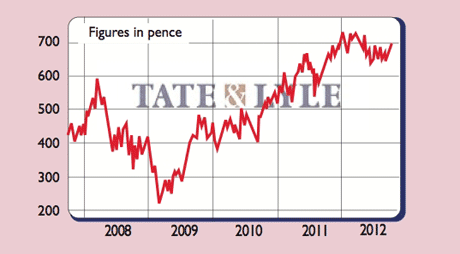Shares in focus: A sugar rush for Tate’s profits
Tate & Lyle faces challenges, but it is a better business than it was a few years ago, says Phil Oakley. So should you buy the shares?
The food processing firmfaces challenges, but the shares are a long-term buy, says Phil Oakley.
The business
Tate & Lyle makes its money by taking corn and sugar and turning them into value-added products. Around three-quarters of all its sales go to the makers of food and drink products. These include stabilisers, thickeners and emulsifiers.
A lot of the company's focus is on selling speciality ingredients, from which it can make good profits. These include the Splenda brand of sucralose sweeteners, fructose crystals, starches and dietary fibres. Tate & Lyle also sells corn-based starches to paper and cardboard companies, ethanol and bio-products that go into textiles and plastics.
MoneyWeek
Subscribe to MoneyWeek today and get your first six magazine issues absolutely FREE

Sign up to Money Morning
Don't miss the latest investment and personal finances news, market analysis, plus money-saving tips with our free twice-daily newsletter
Don't miss the latest investment and personal finances news, market analysis, plus money-saving tips with our free twice-daily newsletter
A small part of the business makes cosmetics, while sucralose is sold to drug companies to make medicines and oral-care products sweeter. Byproducts such as corn feed and gluten meal are sold to animal-feed companies and help reduce the cost of its raw materials. It also supplies bulk commoditised products, such as corn syrup, dextrose and glucose. Last year the group had sales of £3.2bn.
The history
The company can trace its roots back to 1859, when Henry Tate, a Liverpool grocer, went into business with John Wright, a sugar refiner. Together they built sugar refineries in Liverpool and London during the 1870s.
Meanwhile, in 1865, Abram Lyle, a Glasgow-based cooper and shipowner invested in the Glebe sugar refinery. During the 1880s he built his own refinery and started to make Lyle's golden syrup, which is now Britain's oldest brand.
In 1921, Henry Tate & Sons merged with Abram Lyle & Sons to form Tate & Lyle. Significant dates in the company's history include the purchase of United Molasses in 1963 and the discovery of sucralose a calorie-free sweetener made from sugar in 1976.
Tate & Lyle's recent history has been mixed. For years its profits made little progress and moved around in tandem with world sugar prices. The firm spent too much money and had to write down the value of some of its investments.
In 2010, it got out of the sugar and molasses business and began to focus on more profitable speciality food ingredients. As a result, profits have been on an upward trend.
The chief executive
Javed Ahmed has been chief executive since 2009. He started his career at consumer-goods giant Procter & Gamble and spent 17 years at Reckitt Benckiser, where he held a number of prominent roles. He inherited a troubled company at Tate & Lyle, but seems to be doing a good job of sorting it out. He was paid £1.8m for his efforts last year.
Should you buy the shares?
Tate & Lyle is a better business than it was a few years ago. High sugar prices have made its corn sweeteners more attractive and boosted profits. The decision to move away from commoditised sugar markets and focus more on value-added ingredients looks to have been a good one. It is also investing a lot in researching new products to keep the momentum going in this area.
Whether Tate & Lyle is successful or not will depend largely on competition. Its position in the sucralose market is not as secure as it once was. That said, it seems that new sweetener products made from Stevia leaves, Monk fruit extract and Soda-lo a new salt-reducing technology have lots of potential. High corn prices are a concern (Tate & Lyle may not be able to pass all cost increases on to customers), as is a weakening European economy.
Over the longer term, though, the trends towards healthier eating, particularly in convenience foods, should help the company. It also has the potential to sell more of its products in Latin America and Asia. Given that Tate & Lyle's shares are hardly trading on a racy profit multiple, its balance sheet is in good shape and it makes very good returns on its assets, we think the shares are quite attractive. For a patient investor, a long-term investment in the shares could pay off.
The numbers

Stockmarket code: TATE
Share price: 685p
Market cap: £3.2bn
Net assets (March 2012): £1bn
Net debt (March 2012): £476m
P/e (current year estimate): 12.1 times
Yield (prospective): 3.8%
What the analysts say
Buy: 7
Hold: 7
Sell: 2
Average price target695p
Directors' shareholdings

J Ahmed (CEO): 1,041,279
P Gershon (chairman): 69,499
T Lodge (FD): 53,070
Get the latest financial news, insights and expert analysis from our award-winning MoneyWeek team, to help you understand what really matters when it comes to your finances.
Phil spent 13 years as an investment analyst for both stockbroking and fund management companies.
After graduating with a MSc in International Banking, Economics & Finance from Liverpool Business School in 1996, Phil went to work for BWD Rensburg, a Liverpool based investment manager. In 2001, he joined ABN AMRO as a transport analyst. After a brief spell as a food retail analyst, he spent five years with ABN's very successful UK Smaller Companies team where he covered engineering, transport and support services stocks.
In 2007, Phil joined Halbis Capital Management as a European equities analyst. He began writing for MoneyWeek in 2010.
-
 The new 4% rule – how much should retirees really draw from their pension in 2026?
The new 4% rule – how much should retirees really draw from their pension in 2026?Brits retiring in 2026 could be withdrawing too much from their pension pots if they stick to an old rule about ‘safe’ limits – with the risk of running out of money in retirement
-
 Leaving it too late to gift inheritances costs some of Britain’s wealthiest families £3m each
Leaving it too late to gift inheritances costs some of Britain’s wealthiest families £3m eachEven average Brits are being landed with huge and unexpected inheritance tax bills because of a little understood rule around gifting, new figures show
-
 Somero: trading this overlooked bargain
Somero: trading this overlooked bargainFeatures Mechanical-screed maker Somero dominates its niche and is attractively valued. Matthew Partridge picks the best way to trade it.
-
 How to find big profits in small companies
How to find big profits in small companiesCover Story The small- and micro-cap sectors are risky and volatile. But with careful research and patience, investors could make huge gains. Matthew Partridge explains how to find the market’s top tiddlers.
-
 The hidden gems on Aim, London's junior market
The hidden gems on Aim, London's junior marketFeatures Aim, London’s junior market, is risky – but you can find solid stocks at low prices. Scott Longley reports.
-
Three Aim-listed firms that will thrive in a post-Brexit world
Opinion Matt Tonge and Victoria Stevens of the Liontrust UK Smaller Companies Fund pick three Aim-listed firms that will survive Brexit turmoil.
-
Fetch! The Chinese small-cap stocks to buy in the Year of the Dog
Opinion Each week, a professional investor tells us where she’d put her money. This week: Tiffany Hsiao of Matthews Asia selects three Chinese small-cap stocks with exciting potential.
-
Small and mid-cap stocks with big potential
Opinion Professional investor Guy Anderson of the Mercantile Investment Trust selects three small and medium-sized firms with promising prospects that the market has missed.
-
 Get cheap, reliable growth from smaller companies
Get cheap, reliable growth from smaller companiesFeatures One of the most reliable long-term investment trends is the long-term outperformance of smaller companies over blue chips. Max King picks some of the best ways to buy into this growth.
-
 Now the bitcoin bubble’s burst, what’s the next big thing?
Now the bitcoin bubble’s burst, what’s the next big thing?Features Forget bitcoin, if you want to increase your wealth faster than most other people, you need to find the next big thing. Merryn Somerset Webb suggests some places to look.